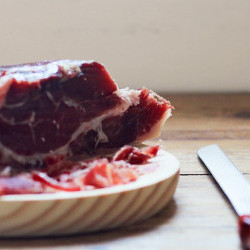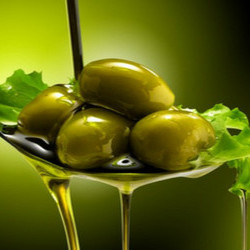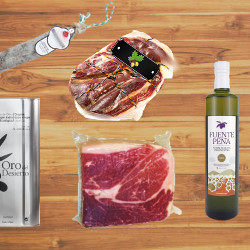
The best pata negra dry ham provided directly from spanish producers
English
- Deutsch CH (German)
- Français (French)
- Italiano (Italian)
- English (United States)
- Castellano (Spanish)
DIFFERENCES BETWEEN THE IBERIAN HAM, YORK AND PROSCIUTTO (PARMA HAM)
In the world there are different types of ham, and in this article we will explain the main differences between Iberian hams, ham and Prosciutto, so you can enjoy them knowing where each one comes from.
The Prosciutto (Parma Ham)
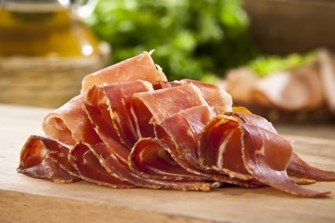
The prosciutto is made from the leg of a pig or boar. The manufacturing process can take between 9 months and 2 years, depending on the size of the ham.
Currently the ham is cleaned first, salted and left to rest for two months. During this time, press, gradually and carefully not to break the bone, to remove all the blood remaining in the meat. Then, wash several times to remove the salt and hang in a dark, well-ventilated place. The ham is then left hanging until it dries. The amount of time needed varies, depending on the local climate and the size of the ham. When the piece is completely dry it hangs in the air, either at room temperature or in a controlled environment, up to 18 months.
Under the Common Agricultural Policy of the European Union, some established meat products, including local varieties of prosciutto, are protected by a protected designation of origin or similar.
The two most famous types of Italian raw prosciutto exported: the prosciutto di Parma, from Parma, and the prosciutto di San Daniele, from the San Daniele del Friuli area, in the Friuli-Venezia Giulia region.
The denominations of origin of prosciutto protected by the European Union, each with a slightly different color, taste and texture, are:
- Prosciutto di Parma, Italy, D.O.P
- Prosciutto di San Daniele, Italy, D.O.P.
- Prosciutto di Modena, Italy, D.O.P.
- Prosciutto Toscano, Italy, D.O.P.
- Prosciutto Veneto Berico-Euganeo, Italy, D.O.P.
- Prosciutto di Carpegna, near Montefeltro, Italy, D.O.P.
- Prosciutto di Norcia, Italy, I.G.P.
- Speck dell'Alto Adige, Italy, I.G.P.
- Prosciutto di Sauris, Italy, I.G.P.
- Crudo di Cuneo, Italy, D.O.P.
The Iberian Ham
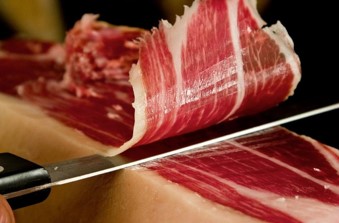
Iberian ham is a type of ham from the Iberian pig, very appreciated in the cuisine of Spain and in the cuisine of Portugal, and often considered as an article of haute cuisine and gastronomic luxury.
For its production must have at least 50% purity of this breed to be able to be called «Iberian ham», although the highest quality will be 100% Iberian hams from Iberian pigs in which both parents will be of race 100 % Iberian. For the rest of the Iberian hams, crosses with the Duroc pig breed are allowed.
The main characteristics that distinguish the Iberian hams in their quality derive from the purity of the breed of the animals, from the breeding in an extensive regime of freedom of the Iberian pig in wooded pastures where they can move widely and perform physical exercise, of the food that follows the pork in the montanera period, and finally the curing of the ham, which usually extends between 24 and 48 months, needing more healing time the larger the size of the piece and the greater amount of acorns the pig has ingested.
The denominations of origin recognized by the European Union of the Iberian pig are:
- Iberian Ham D.O.P. Jabugo
- Iberian Ham D.O.P. The Pedroches.
- Iberian Ham D.O.P. Guijuelo ham
- Iberian Ham D.O.P. Dehesa de Extremadura.
The York Ham
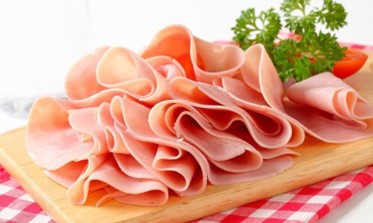
York ham or cooked ham is a cold meat derived from pork that is obtained from the hind limbs of this animal, subjected to cooking in salt water, with or without condiments.
It contains a high content of proteins of high biological value and approximately 100/110 kilocalories per 100 grams, recommended amount in any type of diet, as well as a low fat intake - which makes a lean inlay - and minerals such as sodium , phosphorus, iron, zinc, vitamin b3, B6 and B12. Its pink color and a softer flavor than other hams means that in some places it is also called sweet ham. It consists of a single piece or block, consisting of minced meat of lean and animal fat which is previously injected with a brine in large quantities through a process known as "injection".
It is usually made by various procedures, one of the most common is the injection of a hypodermic needle, at various points in the tissue, of an aqueous salt solution. It can be salted in a traditional way by manual massage, which is currently done mechanically in a rotating drum. The hydration process allows the meat to get a higher volume and reduce its fat content. This product usually has a high content of salt that can harm certain people, which is why there are variants of cooked ham with a lower salt content.

